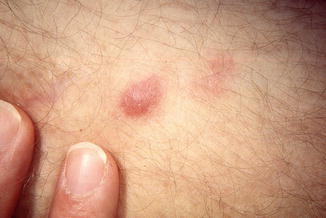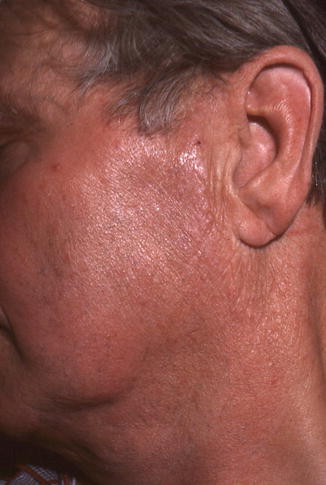Fig. 19.1
This is true cutaneous lymphoma—erythematous papules in the groin. Clinical clues it is a true lymphoma are that the lesions are multiple, chronic, and on non-sun-exposed skin. The histology showed cutaneous T-cell lymphoma. The patient was not on drugs associated with pseudolymphoma

Fig. 19.2
This erythematous papule on histopathology showed pseudolymphoma. It was on the forearm. Clues it might be a pseudolymphoma were that it was acute, solitary, and on sun-exposed skin. The patient was not a medications associated with psuedolymphoma

Fig. 19.3
An erythematous papule with overlying small hemorrhage was seen in an elderly man. Clinical clues of a pseudolymphoma were that it was acute, solitary, and on sun-exposed skin. The pathology showed a psuedolymphoma and the patient was on dilantin. Discontinuation of the dilantin resulted in resolution of the papule
Immunohistochemical markers have also been evaluated as diagnostic tools, but many with disappointing results. Markers common to MF include increased CD4: 8 ratios and loss of CD7, but studies have demonstrated similar changes within TPL. Admixed B- and T-cell infiltrates with evenly scattered CD30 positivity are non-diagnostic but have been suggested to generally represent benign conditions. Recent studies have evaluated the use of programmed death-1 (PD-1) as a possible marker for TPL. Results suggest there is consistent PD-1 positivity in pseudolymphoma and absence in MF. Other studies potentially supporting this assertion have found PD-1 positivity in Sezary syndrome but absence in MF and have suggested its use as a marker to differentiate Sezary syndrome from erythrodermic MF. However, the most prominent distinguishing characteristic is simply the resolution of signs and symptoms upon discontinuation of the inciting medication.
Differential
TPL clinically may present with a wide array of non-specific cutaneous findings. Therefore the differential is of a histologic basis and, most importantly, includes CTCL as discussed above.
Treatment
Treatment of pseudolymphoma, whether B- or T-cell-like, most importantly begins with discontinuation of the causative medication, which alone may lead to resolution of the disease. While numerous medications have been implicated, some of the most commonly reported include various anticonvulsants, antidepressants, antipsychotics, antihypertensives, and antihistamines. Tables 19.1 and 19.2 contain more detailed, although not comprehensive, lists of reported medications for both subsets of pseudolymphoma. Spontaneous and complete resolution often occurs upon stopping the medication and re-exposure is documented to lead to a repeated, if not worsened, eruption. When drug removal alone is insufficient, other local therapies reported to be successful include topical and intralesional corticosteroids, PUVA, cryosurgery, laser ablation, and simple excision. Radiotherapy can be considered for persistent lesions.
Table 19.1
Medications indicted in the etiology of B-cell pseudolymphoma
Medication class | Indicted drugs |
|---|---|
Antibiotics | Penicillin |
Anticonvulsants | Carbamazepine, Lamotrigine, Phenobarbital, Phenytoin |
Antidepressants | Amitriptyline, Doxipin, Fluoxetine |
Antihistamines | Oxatomide |
Antihypertensives | Losartan, Nifedipine, Propranolol |
Antipsychotics | Thioridazine |
Biologics | Ustekinumab |
Bisphosphonates | Zolendronic acid, |
Chemotherapeutics | Methotrexate |
Non-Steroidal Anti-inflammatory Drugs (NSAIDs) | Indomethacin |
Stimulants | Methylphenidate |
Table 19.2
Medications indicted in the etiology of T-cell pseudolymphomas, including DRESS syndrome
Medication class | Indicted medications |
|---|---|
Antiarrhythmics | Digoxin |
Antibiotics | Cefuroxime, Dapsone, Isoniazid, Levofloxacin, Minocycline, Nitrofurantoin, Penicillin, Rifampin, Trimethoprim-sulfamethoxazole, Vancomycin |
Anticonvulsants | Carbamazepine, Ethosuximide, Phenobarbital, Phenytoin, Valproic acid |
Antidepressants | Amitriptyline, Bupropion, Desipramine, Doxepin, Fluoxetine, Maprotiline |
Antihistamines | Cimetidine, Doxepin, Diphenhydramine, Mequitazine, Ranitidine |
Antihypertensives | Atenolol, Amlodipine, Clonidine, Captopril, Diltiazem, Enalapril, Furosemide, Hydralazine, Hydrochlorothiazide, Lisinopril, Losartan, Prazosin, Spironolactone, Valsartan, Verapamil |
Antipsychotics | Chlorpromazine, Lithium, Phenothiazine, Thioridazine |
Antirheumatics | Allopurinol, D-penicillamine, Gold, Sulfasalazine |
Anti-TNF alpha agents | Adalimumab, Etanercept, Infliximab |
Chemotherapeutics | Cyclosporine, Fluorouracil, Gemcitabine, Imatinib, Leucovorin, Methotrexate, Oxaliplatin |
Cholesterol-lowering agents | Lovastatin |
Nitrates | Isosorbide dinitrate, Nitroglycerin |
Nonsteroidal anti-inflammatory drugs (NSAIDs) | Diclofenac, Fenoprofen, Ibuprofen, Indomethacin, Lornoxicam, Naproxen
Stay updated, free articles. Join our Telegram channel
Full access? Get Clinical Tree
 Get Clinical Tree app for offline access
Get Clinical Tree app for offline access

|